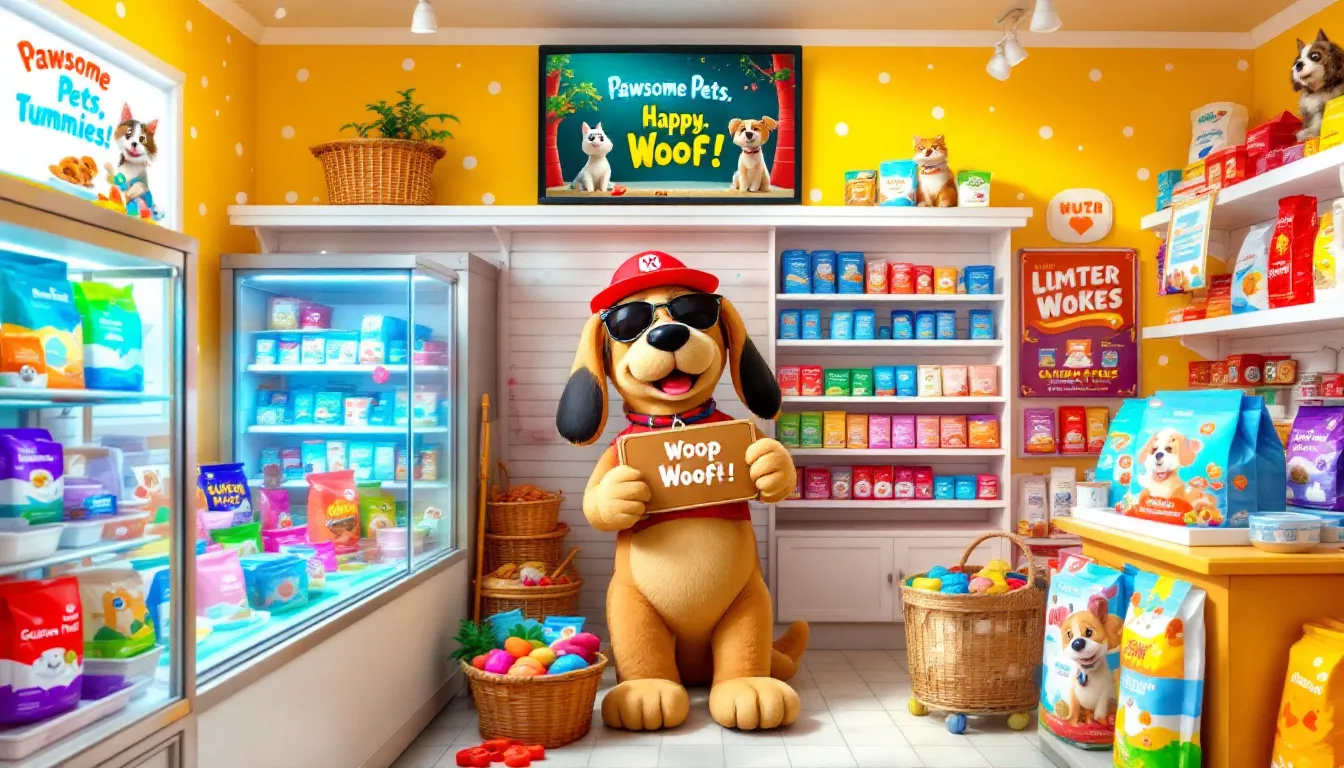Why is the pet food industry booming? In 2023, the market size hit USD 103.3 billion due to more pets and greater focus on their health. This article covers the trends, key players and future growth of the industry.
Market overview
.jpg?width=967&height=811&name=Untitled%20design%20(52).jpg)
The global pet food market has seen substantial growth over the past few years. In 2023, the market size was estimated at USD 103.3 billion, and it is anticipated to reach USD 139.29 billion by 2030. This robust growth is driven by several factors, including the increasing number of pet owners and heightened awareness about pet health and nutrition.
In the United States, the pet food industry has consistently expanded, with total sales projected to hit $53.2 billion by the end of 2023. This growth is mirrored in Europe, where pet food expenditure was approximately $36.4 billion in 2023. The trend of pet humanization, where pets are treated as family members, is significantly influencing market dynamics and driving the demand for premium and nutritious food options.
The pandemic has also played a role in the market’s expansion, as more individuals adopted pets during lockdown periods, leading to increased spending on pet food. As consumer awareness about pet health continues to rise, the market is expected to see sustained growth, with a shift towards premium and specialized products.
Regional market insights
Understanding regional market trends is crucial for comprehending the global pet food industry’s full scope. North America, Europe, and the Asia-Pacific region each present unique market dynamics and growth opportunities.
These regions are being reshaped by consumer preferences, regulatory environments, and economic factors, creating a complex but promising landscape for pet food companies.
North America dominance
North America led the pet food market in 2023, holding a 42.87% revenue share, driven by high pet adoption rates and a preference for premium and specialized pet food products. Rising consumer awareness about pet nutrition and the humanization of pets further drive the demand for high-quality products in this region.
In North America, consumer preferences are shifting towards premium and specialized pet food products due to increased awareness about pet nutrition. With rising pet ownership, the market is anticipated to grow steadily, emphasizing premium and specialized products. This trend highlights the region’s importance in the global market and its influence on market dynamics.
Europe’s growing market
Europe’s pet food market has grown significantly, driven by the rising trend of pet humanization and an increasing demand for nutritious food options. Pet owners in Europe are increasingly treating their pets as family members, leading to higher spending on premium and fortified pet food products. This trend is reshaping the market, with a growing focus on quality nutrition.
Growing awareness of pet health among European consumers fuels the demand for premium and nutritious pet food products. Consequently, the market is projected to grow steadily during the forecast period, significantly influencing global market trends. This rising trend highlights Europe’s evolving pet food market and its potential for future expansion.
Emerging markets in Asia-Pacific
The Asia-Pacific region is witnessing rapid growth in the pet food market, driven by rising disposable incomes and an increase in pet ownership. In countries like China and South Korea, urban households are increasingly adopting pets as companions, contributing to market expansion. This growing trend is reshaping the pet food landscape in the region.
China dominates the Asia-Pacific pet food market, with an increasing focus on nutritional supplements and natural ingredients. As consumer preferences evolve and demand for high-quality pet food grows, Asia-Pacific is set to become one of the largest markets in the global pet food industry.
Pet food product segments
The pet food market is diverse, with various product segments catering to different types of pets. In 2023, the dog and cat food segment represented 85.3% of the overall pet food market.
This section delves into the specifics of the dog food, cat food, and other niche pet food segments, highlighting their market share, growth drivers, and consumer preferences.
Dog food segment
.jpg?width=963&height=807&name=Untitled%20design%20(53).jpg)
Dog food accounts for 42.1% of the pet food market’s revenue share in 2023, making it a significant segment. Dry dog food, in particular, is favored by many owners due to its affordability, ease of storage, and health benefits. Dry dog food remains popular due to its convenience, longer shelf-life, and cost-effectiveness.
The dog food segment’s growth is further driven by the trend of pet humanization, where owners treat their dogs as family members and prioritize their health and nutrition. This trend is expected to continue driving the demand for premium and specialized dog food products, contributing to the overall pet food market growth.
Cat food segment
.jpg?width=964&height=808&name=Untitled%20design%20(54).jpg)
Cat food holds a significant market share primarily due to health concerns and balanced diet requirements. Pet owners are increasingly focused on providing their cats with nutritious and balanced diets, which enhances the market significance of cat food. Wet pet food is particularly favored among owners due to its perceived health benefits and palatability.
The focus on health and diet indicates strong growth potential for the cat food segment in the market. As owners prioritize their cats’ health, the demand for high-quality, nutritious cat food is set to rise, boosting overall market growth.
Other pet food products
.jpg?width=963&height=807&name=Untitled%20design%20(55).jpg)
Niche pet food markets, including those for birds, fish and small mammals, are showing growth as pet owners seek specialized nutrition for their pet’s food. The market for pet food aimed at animals other than dogs and cats is increasingly significant, catering to species like birds and fish. This growing trend underscores the evolving landscape of the pet food industry, expanding beyond traditional dog and cat food.
Products for small mammals are increasingly popular as pet owners seek diverse diets for their domesticated animals. This trend underscores the need to cater to the diverse needs of pet owners and their pets, driving overall market growth.
Key market dynamics
Growing awareness about pet health is leading to increased consumer spending on nutritious food options for pets, contributing to their overall well being. This awareness is driving the demand for premium pet food products, as owners seek to provide their pets with the best possible nutrition. The trend of humanization of pets significantly influences this demand, as pets are increasingly treated as family members.
Strict regulations and sustainability claims are reshaping how brands communicate product benefits, influencing consumer choices. These factors underscore the importance of transparency and quality in the pet food market, as consumers become more discerning. As a result, the market is expected to see continued growth driven by these key dynamics.
Leading companies & competitive landscape
In 2023, the U.S. pet food market was led by:
- Nestlé Purina PetCare, with revenues of approximately $21.47 billion
- Mars Petcare Inc., ranking second with around $20 billion in revenue
- Hill’s Pet Nutrition, generating revenues of $3.78 billion
- General Mills, with revenues of $2.5 billion
The competitive landscape of the pet food market is moderately consolidated, with key manufacturers focusing on developing innovative formulas and high-quality food. Industry participants are adopting new marketing strategies, advanced technologies, expansion, mergers, and acquisitions to stay competitive.
This dynamic environment highlights the need for innovation and strategic growth in the pet food industry.
Innovations in pet food

Increasing consumer awareness about sustainability is prompting brands to adopt eco-friendly practices in their product offerings. Innovative loyalty programs and subscription services, like Chewy’s Autoship, are increasingly vital in retaining customers in the competitive pet food market. These trends highlight the pet food industry’s adaptation to modern consumer demands.
Sustainability is now a key factor for consumers when selecting pet food products. Brands are incorporating sustainable practices and innovative ingredients to cater to health-conscious pet owners. These innovations are driving the growth of premium and specialized pet food products, contributing to the overall market expansion.
Distribution channels
.jpg?width=962&height=807&name=Untitled%20design%20(56).jpg)
E-commerce is becoming a significant sales channel for pet food in the Asia-Pacific region, capturing an increasing portion of the market. The share of e-commerce in the global pet care market increased significantly, rising from over 10% in 2017 to more than 20% in 2020. By 2026, it’s predicted that nearly one-third of global pet sales will be conducted through e-commerce platforms.
Traditional pet stores are expanding online to adapt to the e-commerce shift. Retailers are offering services like click-and-collect and curbside pickup to meet changing consumer preferences.
Online retailers, including generalists like Amazon and specialized pet product websites like Chewy, are capturing a growing portion of pet food sales.
Market challenges and opportunities

The pet food industry is facing challenges from rising living costs, which impact purchasing power and consumer spending patterns. Rising raw material costs and supply chain disruptions can hinder production and increase prices. Labor shortages in the pet food manufacturing sector, intensified by the COVID-19 pandemic, complicate production processes.
Despite these challenges, growth opportunities exist as demand for premium and natural pet food products rises. Adhering to evolving regulatory standards presents ongoing challenges for manufacturers, requiring rigorous safety testing and quality control.
These factors underscore the dynamic nature of the pet food market, where challenges and opportunities shape its future.
Global market projections
The global pet food market size is projected to expand from approximately $1,954.8 million in 2020 to $4,676.1 million by 2030, achieving a compound annual growth rate (CAGR) of 8.8% from 2021 to 2030. The market is projected to grow from USD 112.13 billion in 2021 to USD 170.11 billion by 2030, reflecting a CAGR of 4.5%. This robust growth is driven by increasing pet ownership and consumer awareness about pet health, contributing to global market growth.
The U.S. pet food market is projected to reach $195.6 billion in sales by 2030, reflecting significant growth trends. In North America, the market is projected to reach $1,148.6 million by 2030, growing at a CAGR of 7.0%.
The organic segment within the pet food market is expected to see significant growth, with projections estimating it will reach $1,117.4 million by 2030 at a CAGR of 11.7%. These projections underscore the market’s potential and the growing trend towards customized pet food products.
Role of consulting firms

Consulting firms play a crucial role in the pet food industry by providing essential insights into market dynamics and helping brands develop effective growth strategies. Firms like GC Consulting specialize in exporting and creating new pet food brands tailored for diverse global markets. With over 10 years of industry experience, GC Consulting has developed an extensive network of manufacturers, distributors and brand owners.
These firms assist businesses in expanding into global markets by offering valuable market insights and strategic guidance. Their expertise and extensive network enable pet food companies to navigate the complex market landscape and capitalize on growth opportunities. This support is crucial for companies aiming to stay competitive and achieve sustainable growth in the pet food industry.
Summary
The pet food industry is on an exciting trajectory of growth and innovation. From the significant market share held by North America to the rapid expansion in the Asia-Pacific region, the global pet food market is dynamic and evolving. Key trends like the humanization of pets, increasing consumer awareness of pet health, and the demand for premium products are driving market growth. The industry’s leading companies, such as Nestlé Purina PetCare and Mars Petcare Inc., are shaping the competitive landscape with their innovative strategies and high-quality offerings.
As we look to the future, the pet food market is expected to continue its upward trajectory, with significant growth projected across various regions and segments. Consulting firms like GC Consulting play a vital role in helping businesses navigate this complex landscape and capitalize on emerging opportunities. By staying informed and adapting to market trends, companies can ensure they remain competitive and meet the evolving needs of pet owners worldwide.
Frequently asked questions
What is the current size of the global pet food market?
The global pet food market size is currently estimated at USD 103.3 billion in 2023, with projections indicating growth to USD 139.29 billion by 2030.
Which region holds the largest share in the pet food market?
North America holds the largest share of the pet food market, accounting for 42.87% of revenue in 2023, primarily due to high pet adoption rates and a preference for premium products.
What factors are driving the growth of the pet food market in Europe?
The pet food market in Europe is primarily driven by the pet humanization trend and the rising demand for premium, nutritious pet food options. These factors reflect consumers' desire to provide better quality and healthier diets for their pets.
How is the Asia-Pacific region contributing to the pet food market's growth?
The Asia-Pacific region is significantly contributing to the pet food market's growth through rising disposable incomes, a surge in pet ownership and expanding markets in key countries like China and South Korea. This dynamic landscape is driving demand for diverse and premium pet products.
What role do consulting firms play in the pet food market?
Consulting firms, like GC Consulting, play a critical role in the pet food market by offering valuable insights into market dynamics and aiding businesses in developing growth strategies for global expansion. They help create tailored pet food brands, facilitating entry into diverse markets.


.jpg)
